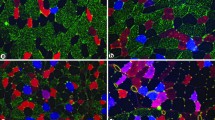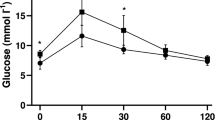Abstract
Muscle fiber area, capillary density, and capillary to fiber ratio were determined in needle biopsy samples ofM. vastus lateralis processed for electron microscopy from 9 untrained men (average\(\dot V_{{\text{O}}_{\text{2}} }\)max = 61.3 ml/min kg), 3 untrained women (\(\dot V_{{\text{O}}_{\text{2}} }\)max = 43.7 ml/min kg) and 5 well trained orienteers (\(\dot V_{{\text{O}}_{\text{2}} }\)max = 76.1 ml/min kg). The volume density of mitochondria was previously reported to be significantly higher in orienteers (7.32%) than in untrained men (5.19%) and in untrained women (4.08%) in the same material (Hoppeler et al. 1973).
The mean fiber area was found to be somewhat larger in orienteers (6,410 μm2 than in untrained men (5,350 μm2, not significant), but significantly smaller values were found in untrained women (3,390 μm2). The capillary density was almost identical in the three experimental groups, it ranged from 416 to 431 mm−2. The absolute values reported for both of the above variables are subjected to a bias due to fiber shrinkage, fiber shortening and fiber kinking occurring during the needle biopsy procedure and the subsequent steps of tissue preparation. The capillary to fiber ratio is much less affected by tissue handling and significantly higher values were found in orienteers (2.70) than in untrained men (2.07) and in untrained women (1.37). There was a significant linear relationship between the capillary to fiber ratio and both\(\dot V_{{\text{O}}_{\text{2}} }\)max and the volume density of mitochondria for all subjects analysed, suggesting an adjustment of the capillary supply to the maximal aerobic capacity as well as to the mitochondrial content inM. vastus lateralis.
Similar content being viewed by others
References
Andersen P (1975) Capillary density in skeletal muscle of man. Acta Physiol Scand 95:203–205
Andersen P, Henriksson J (1977) Capillary supply of the quadriceps femoris muscle of man: Adaptive response to exercise. J Physiol 270:677–690
Andersen P, Kroese AJ (1978) Capillary supply in soleus and gastrocnemius muscles of man. Pflügers Archiv 375:245–249
Appell HJ, Brunner W (1979) Über die Veränderungen der terminalen Strombahn in der Skelettmuskulatur unter experimentellen Bedingungen. Verh Anat Ges 73:865–867
Brodal P, Ingjer F, Hermansen L (1977) Capillary supply of skeletal muscle fibers in untrained and endurance-trained men. Am J Physiol 232:H705-H712
Bylund A, Bjurö T, Cederblad G, Holm J, Lundholm K, Sjöström M, Aengquist KA, Schersten T (1977) Physical training in man. Skeletal muscle metabolism in relation to muscle morphology and running ability. Eur J Physiol 36:151–169
Cochran WG (1977) Sampling Techniques, 3rd ed. Wiley, New York, p 428
Cruz-Orive LM (1982) The use of quadrats and test systems in stereology including magnification corrections. J Microsc 125:89–102
Gollnick PD, Timson BF, Moore R, Riedy M (1981) Muscular enlargement and number of fibers in skeletal muscles of rats. J Appl Physiol 50:936–943
Gray SD, Renkin EM (1978) Microvascular supply in relation to fiber metabolic type in mixed skeletal muscles of rabbits. Microvasc Res 16:406–425
Gundersen HJG (1977) Notes on the estimation of the numerical density of arbitrary profiles: the edge effect. J Microsc 111:219–223
Hammersen F (1968) The pattern of the terminal vascular bed and the ultrastructure of capillaries in skeletal muscle. In: Lübbers DW, Luft UC, Thews G, Witzleb E (eds) Oxygen transport in blood and tissue. Thieme, Stuttgart, pp 184–197
Hermansen L, Wachtlova M (1971) Capillary density of skeletal muscle in well-trained and untrained men. J Appl Physiol 30:860–863
Hoppeler H, Lüthi P, Claassen H, Weibel ER, Howald H (1973) The ultrastructure of the normal human skeletal muscle. A morphometric analysis on untrained men, women and well-trained orienteers. Pflügers Arch 344:217–232
Hoppeler H, Mathieu O, Bretz R, Krauer R, Weibel ER (1980) The use of small computer systems for stereology. Mikroskopie 37 Suppl:408–412
Hoppeler H, Mathieu O, Weibel ER, Krauer R, Lindstedt SL, Taylor CR (1981) Design of the mammalian respiratory system. VIII. Capillaries in skeletal muscles. Respir Physiol 44:129–150
Ingjer F (1978) Maximal aerobic power related to the capillary supply of the quadriceps femoris muscle in man. Acta Physiol Scand 104:238–240
Ingjer F (1979) Effects of endurance training on muscle fibre ATP-ase activity, capillary supply and mitochondrial content in man. J Physiol 294:419–432
Ingjer F, Brodal P (1978) Capillary supply of skeletal muscle fibers in untrained and endurance-trained women. Eur J Appl Physiol 38:291–299
James NT (1981) A stereological analysis of capillaries in normal and hypertrophic muscle. J Morphol 168:43–49
Jansson E, Kaijser L (1977) Muscle adaptation to extreme endurance training in man. Acta Physiol Scand 100:315–324
Mathieu O, Hoppeler H, Cruz-Orive LM, Weibel ER (1981) Stereological estimation of the length density of anisotropic structures: Capillaries in skeletal muscle. Stereol Jugosl Proc 3rd Eur Symp Stereol Ljubljana, 3 Suppl. 1:643–647
Mathieu O, Cruz-Orive LM, Hoppeler H, Weibel ER: Estimating length density and quantifying anisotropy in skeletal muscle capillaries. J Microsc (in press)
Maxwell LC, White TP, Faulkner JA (1980) Oxidative capacity, bloodflow and capillarity of skeletal muscles. J Appl Physiol 49:627–633
Plyley MJ, Groom AC (1975) Geometrical distribution of capillaries in mammalian striated muscle. Am J Physiol 228:1376–1383
Saltin B, Blomqvist G, Mitchell JH, Johnson K, Wildenthal K, Chapman CB (1968) Response to exercise after bed rest and after training. Circulation 38: Suppl VII:1–78
Saltin B, Henriksson J, Nygaard E, Andersen P (1977) Fiber types and metabolic potentials of skeletal muscles in sedentary man and endurance runners. Ann NY Acad Sci 301:3–29
Taylor CR, Weibel ER (1981) Design of the mammalian respiratory system. I. Problem and strategy. Respir Physiol 44:1–10
Weibel ER (1979) Stereological methods. Practical methods for biological morphometry, vol. 1. Academic Press, London New York Toronto, p 415
Weibel ER (1980) Stereological methods. Theoretical foundations, vol 2. Academic Press, London New York Toronto
Author information
Authors and Affiliations
Rights and permissions
About this article
Cite this article
Zumstein, A., Mathieu, O., Howald, H. et al. Morphometric analysis of the capillary supply in skeletal muscles of trained and untrained subjects — Its limitations in muscle biopsies. Pflugers Arch. 397, 277–283 (1983). https://doi.org/10.1007/BF00580261
Received:
Accepted:
Issue Date:
DOI: https://doi.org/10.1007/BF00580261




